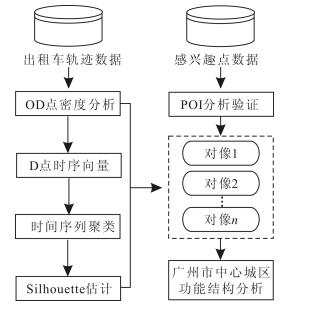Sensing Multi-level Urban Functional Structures by Using Time Series Taxi Trajectory Data
-
摘要: 地理时空大数据被广泛用于城市功能结构识别,其中功能层次性的研究对于系统理解城市功能的结构特征和分布形态具有重大意义,但相关研究仍处于空缺状态。基于时序出租车出行数据和感兴趣点数据描述居民出行模式,结合动态时间规整和K-MEDOIDS聚类算法识别城市的功能属性和空间结构。研究结果表明,广州市中心城区的城市功能具有明显的层次性。随着层次细致程度的提升,其功能属性由"职-住"二元结构向"职-住-休"三元结构发展;其空间结构符合环状圈层构造,功能由外围的居住游憩向中心的商业休闲过渡,并在不同的圈层上呈现出各自的功能倾向。这为城市规划人员系统理解城市功能的属性变化和结构特征提供了有效的参考价值。Abstract: Geospatial big data has been widely applied to distinguish urban functions. Especially, the research of functional hierarchy is of profound significance in understanding the structural characteristics and distributional forms of urban functions thoroughly, but related studies are still vacant. Therefore, this study depicts human mobility patterns based on time-series taxi trajectory data and point of interests (POIs) data, and identifies urban functional properties and spatial structures through combining dynamic time warping and K-MEDOIDS clustering algorithm. The results show that the urban functions in the central area of Guangzhou possess obvious hierarchical characteristics. With the refinement of hierarchies, the functional properties are developed from the dual-structure of working-living into the triple-structure of working-living-entertainment gradually. Moreover, the spatial structure is consistent with the ring-shaped structure, and its urban functions are gradually transformed from the living-entertainment function at outer rings into the commercial-entertainment function at central rings, and present different tendencies at different rings. This study provides efficient references for urban planners to understand the property changes and structural characteristics of urban functions.
-
-
表 1 功能区POIs密度和富集指数
Table 1 Density and Enrichment Factor of POIs in Functional Zones

-
[1] Zhong Y, Zhu Q, Zhang L. Scene Classification Based on the Multifeature Fusion Probabilistic Topic Model for High Spatial Resolution Remote Sensing Imagery[J]. IEEE Transactions on Geoscience and Remote Sensing, 2015, 53(11):6207-6222 doi: 10.1109/TGRS.2015.2435801
[2] Liu Y, Liu X, Gao S, et al. Social Sensing:A New Approach to Understanding Our Socioeconomic Environments[J]. Annals of the Association of American Geographers, 2015, 105(3):1-19
[3] Yin J, Yin Z, Zhong H, et al. Monitoring Urban Expansion and Land Use/Land Cover Changes of Shanghai Metropolitan Area During the Transitional Economy (1979-2009) in China[J]. Environmental Monitoring and Assessment, 2011, 177(1-4):609-621 doi: 10.1007/s10661-010-1660-8
[4] Liu X, He J, Yao Y, et al. Classifying Urban Land Use by Integrating Remote Sensing and Social Media Data[J]. International Journal of Geographical Information Science, 2017, 31(8):1675-1696 doi: 10.1080/13658816.2017.1324976
[5] Tu W, Cao J, Yue Y, et al. Coupling Mobile Phone and Social Media Data:A New Approach to Understanding Urban Functions and Diurnal Patterns[J]. International Journal of Geographical Information Science, 2017, 31(12):2331-2358 doi: 10.1080/13658816.2017.1356464
[6] Yao Y, Li X, Liu X, et al. Sensing Spatial Distribution of Urban Land Use by Integrating Points-of-Interest and Google Word 2 Vec Model[J]. International Journal of Geographical Information Science, 2017, 31(4):825-848 doi: 10.1080/13658816.2016.1244608
[7] 钮心毅, 丁亮, 宋小冬.基于手机数据识别上海中心城的城市空间结构[J].城市规划学刊, 2014(6):61-67 doi: 10.3969/j.issn.1000-3363.2014.06.009 Niu Xinyi, Ding Liang, Song Xiaodong. Understanding Urban Spatial Structure of Shanghai Central City Based on Mobile Phone Data[J]. Urban Planning Forum, 2014(6):61-67 doi: 10.3969/j.issn.1000-3363.2014.06.009
[8] 曹瑞, 涂伟, 巢佰崇, 等.基于智能卡数据的地铁周边职住用地识别与分析[J].测绘地理信息, 2016, 41(3):74-78 http://d.old.wanfangdata.com.cn/Periodical/chxxygc201603018 Cao Rui, Tu Wei, Chao Baichong, et al. Identification and Analysis of Home and Work Regions in the Vicinity of Metro Stations Using Smart Card Data[J]. Journal of Geomatics, 2016, 41(3):74-78 http://d.old.wanfangdata.com.cn/Periodical/chxxygc201603018
[9] Zheng Y, Capra L, Wolfson O, et al. Urban Computing:Concepts, Methodologies, and Applications[J]. ACM Transactions on Intelligent Systems and Technology, 2014, 5(3):1-55 http://d.old.wanfangdata.com.cn/NSTLQK/NSTL_QKJJ0211015097/
[10] Yuan J, Zheng Y, Xie X. Discovering Regions of Different Functions in a City Using Human Mobility and Pois[Z]. ACM, 2012
[11] Liu Y, Kang C, Gao S, et al. Understanding Intra-Urban Trip Patterns from Taxi Trajectory Data[J]. Journal of Geographical Systems, 2012, 14(4):463-483 doi: 10.1007/s10109-012-0166-z
[12] Liu Y, Wang F, Xiao Y, et al. Urban Land Uses and Traffic 'Source-Sink Areas':Evidence from GPS-Enabled Taxi Data in Shanghai[J]. Landscape and Urban Planning, 2012, 106(1):73-87 doi: 10.1016/j.landurbplan.2012.02.012
[13] 刘瑜, 康朝贵, 王法辉.大数据驱动的人类移动模式和模型研究[J].武汉大学学报·信息科学版, 2014, 39(6):660-666 http://ch.whu.edu.cn/CN/abstract/abstract3011.shtml Liu Yu, Kang Caogui, Wang Fahui. Towards Big Data-Driven Human Mobility Patterns and Models[J]. Geomatics and Information Science of Wuhan University, 2014, 39(6):660-666 http://ch.whu.edu.cn/CN/abstract/abstract3011.shtml
[14] 蒋云良, 董墨萱, 范婧, 等.基于POI数据的城市功能区识别方法研究[J].浙江师范大学学报(自然科学版), 2017, 40(4):7-10 http://d.old.wanfangdata.com.cn/Periodical/zjsdxb201704007 Jiang Yunliang, Dong Moxuan, Fan Jing, et al. Research on Identifying Urban Regions of Different Functions Based on POI Data[J]. Journal of Zhejiang Normal University(Nat Sci), 2017, 40(4):7-10 http://d.old.wanfangdata.com.cn/Periodical/zjsdxb201704007
[15] Pan G, Qi G, Wu Z, et al. Land-Use Classification Using Taxi GPS Traces[J]. IEEE Transactions on Intelligent Transportation Systems, 2013, 14(1):113-123 doi: 10.1109/TITS.2012.2209201
[16] 孙志刚.城市功能论[M].北京:经济管理出版社, 1998 Sun Zhigang. Urban Function Theory[M]. Beijing:Economy and Management Press, 1998
[17] 杨俊宴, 吕传廷, 杨明, 等.广州城市中心体系规划研究[J].城市规划, 2011(10):23-31 http://d.old.wanfangdata.com.cn/Periodical/csgh201110004 Yang Junyan, Lü Chuanting, Yang Ming, et al. Research on Urban Center System Planning of Guangzhou[J]. City Planning Review, 2011(10):23-31 http://d.old.wanfangdata.com.cn/Periodical/csgh201110004
[18] 张京祥.西方城市规划思想史纲[M].南京:东南大学出版社, 2005 Zhang Jingxiang. A Brief History of Western Urban Planning Thought[M]. Nanjing:Southeast University Press, 2005
[19] Gunopulos D, Das G. Time Series Similarity Measures and Time Series Indexing[J]. ACM SIGMOD Recard, 2001, 30(2):624 doi: 10.1145/376284
[20] Bagnall A, Janacek G. Clustering Time Series with Clipped Data[J]. Machine Learning, 2005, 58(2):151-178
[21] Petitjean F C C O, Ketterlin A, Gan C C, et al. A Global Averaging Method for Dynamic Time Warping, with Applications to Clustering[J]. Pattern Recognition, 2011, 44(3):678-693 doi: 10.1016/j.patcog.2010.09.013
[22] Mirkin B. Clustering:A Data Recovery Approach[M]. 2nd ed.New York:CRC Press, 2012
[23] Rousseeuw P J. Silhouettes:A Graphical Aid to the Interpretation and Validation of Cluster Analysis[J]. Journal of Computational and Applied Mathematics, 1987(20):53-65 http://d.old.wanfangdata.com.cn/Periodical/zgtxtxxb-a200208012
[24] Verburg P H, de Nijs T C, van Eck J R, et al. A Method to Analyse Neighbourhood Characteristics of Land Use Patterns[J]. Computers, Environment and Urban Systems, 2004, 28(6):667-690 doi: 10.1016/j.compenvurbsys.2003.07.001
[25] Wei Y D, Ye X. Urbanization, Urban Land Expansion and Environmental Change in China[J]. Stochastic Environmental Research and Risk Assessment, 2014, 28(4):757-765 doi: 10.1007/s00477-013-0840-9
[26] Liu Y, Fang F, Li Y. Key Issues of Land Use in China and Implications for Policy Making[J]. Land Use Policy, 2014, 40:6-12 doi: 10.1016/j.landusepol.2013.03.013
-
期刊类型引用(3)
1. 周永章,陈川,张旗,王功文,肖凡,沈文杰,卞静,王亚,杨威,焦守涛,刘艳鹏,韩枫. 地质大数据分析的若干工具与应用. 大地构造与成矿学. 2020(02): 173-182 .  百度学术
百度学术
2. 王叶晨梓,杜震洪,张丰,刘仁义. 面向分片地图的多分辨率格点数据统一存取方法. 浙江大学学报(理学版). 2017(05): 584-590 .  百度学术
百度学术
3. 朱建章,石强,陈凤娥,史晓丹,董泽民,秦前清. 遥感大数据研究现状与发展趋势. 中国图象图形学报. 2016(11): 1425-1439 .  百度学术
百度学术
其他类型引用(6)






 下载:
下载:










